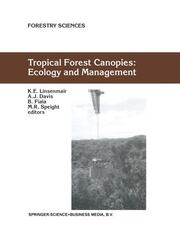-
Zusatztext
-
InhaltsangabeForeword; K.E. Linsenmair. Introduction: Canopy Science: time to shape up; A. Mitchell. Section 1: Sampling and access. Alice grows up: canopy science in transition from Wonderland to Reality; S.L. Sutton. Forest canopy research: sampling problems, and some solutions; M.G. Barker, M.A. Pinard. Section 2: Plants in the canopy. Plants in the forest canopy: some reflections on current research and future direction; M.D. Lowman. Epiphytes and their contribution to canopy diversity; J. Nieder, et al. Plant size: an ignored parameter in epiphyte ecophysiology? G. Schmidt, et al. Pollination and phenology of flowers in the canopy of two contrasting rain forest types in Amazonia, Colombia; A. van Dulmen. Section 3: Animals in the canopy. Invertebrates in the canopy of tropical rain forests: how much do we really know; Y. Basset. Arboreal tropical forest vertebrates: current knowledge and research trends; R. Kays, A. Allison. Vertical stratification of figs and fig-eaters in a Bornean lowland rain forest: how is the canopy different? M. Shanahan, S.G. Compton. Understorey versus canopy: patterns of vertical stratification and diversity among Lepidoptera in a Bornean rain forest; C.H. Schulze, et al. The influence of anthropogenic disturbances on the structure of arboreal arthropod communities; A. Floren, K.E. Linsenmair. Seasonal changes in the canopy arthropod fauna in Rinorea beniensis in Budongo Forest, Uganda; T. Wagner. Arthropods in tropical oaks: differences in their spatial distributions within tree crowns; U. Simon, K.E. Linsenmair. Behaviour and ecology of birds in tropical rain forest canopies; H. Winkler, M. Preleuthner. Section 4: Hydrology, microclimate andlight. Canopy processes: implications for transpiration, interception and splash induced erosion, ultimately for forest management and water resources; I.R. Calder. Modelling rainfall and canopy controls on net-precipitation beneath selectively-logged tropical forest; N.A. Chappell, et al. Micrometeorological conditions and canopy energy exchanges of a neotropical rain forest (Suromoni-Crane Project, Venezuela); J. Szarzynski, D. Anhuf. The influence of epiphyte cover on branch temperature in a tropical tree; M. Freiberg. Forest light and its influence on habitat selection; M. Théry. Section 5: Architecture. Methods to assess tropical rain forest canopy structure: an overview; F. Bongers. Three architecture in a Bornean lowland rain forest: intra- and inter-specific patterns; F.J. Sterck, et al. Canopy surface topography in a French Guiana forest and the folded forest theory; P. Birnbaum. Crown typography and the identification of rain forest trees on large-scale aerial photographs; V. Trichon. Section 6: Education, management and conservation. The management implications of canopy research; N.E. Stork. Neotropical bats in the canopy: diversity, community structure, and implications for conservation; E.K.V. Kalko, C.O. Handley. Reproductive ecology of tropical forest trees in logged and fragmented habitats in Thailand and Costa Rica; J. Ghazoul, M. McLeish. Edge effects and tropical forest canopy invertebrates; A. Foggo, et al. Enhancement of forest canopy research, education, and conservation in the new millennium; N.M. Nadkarni. Index.
-
-
Autorenportrait
- InhaltsangabeForeword; K.E. Linsenmair. Introduction: Canopy Science: time to shape up; A. Mitchell. Section 1: Sampling and access. Alice grows up: canopy science in transition from Wonderland to Reality; S.L. Sutton. Forest canopy research: sampling problems, and some solutions; M.G. Barker, M.A. Pinard. Section 2: Plants in the canopy. Plants in the forest canopy: some reflections on current research and future direction; M.D. Lowman. Epiphytes and their contribution to canopy diversity; J. Nieder, et al. Plant size: an ignored parameter in epiphyte ecophysiology? G. Schmidt, et al. Pollination and phenology of flowers in the canopy of two contrasting rain forest types in Amazonia, Colombia; A. van Dulmen. Section 3: Animals in the canopy. Invertebrates in the canopy of tropical rain forests: how much do we really know; Y. Basset. Arboreal tropical forest vertebrates: current knowledge and research trends; R. Kays, A. Allison. Vertical stratification of figs and fig-eaters in a Bornean lowland rain forest: how is the canopy different? M. Shanahan, S.G. Compton. Understorey versus canopy: patterns of vertical stratification and diversity among Lepidoptera in a Bornean rain forest; C.H. Schulze, et al. The influence of anthropogenic disturbances on the structure of arboreal arthropod communities; A. Floren, K.E. Linsenmair. Seasonal changes in the canopy arthropod fauna in Rinorea beniensis in Budongo Forest, Uganda; T. Wagner. Arthropods in tropical oaks: differences in their spatial distributions within tree crowns; U. Simon, K.E. Linsenmair. Behaviour and ecology of birds in tropical rain forest canopies; H. Winkler, M. Preleuthner. Section 4: Hydrology, microclimate andlight. Canopy processes: implications for transpiration, interception and splash induced erosion, ultimately for forest management and water resources; I.R. Calder. Modelling rainfall and canopy controls on net-precipitation beneath selectively-logged tropical forest; N.A. Chappell, et al. Micrometeorological conditions and canopy energy exchanges of a neotropical rain forest (Suromoni-Crane Project, Venezuela); J. Szarzynski, D. Anhuf. The influence of epiphyte cover on branch temperature in a tropical tree; M. Freiberg. Forest light and its influence on habitat selection; M. Théry. Section 5: Architecture. Methods to assess tropical rain forest canopy structure: an overview; F. Bongers. Three architecture in a Bornean lowland rain forest: intra- and inter-specific patterns; F.J. Sterck, et al. Canopy surface topography in a French Guiana forest and the folded forest theory; P. Birnbaum. Crown typography and the identification of rain forest trees on large-scale aerial photographs; V. Trichon. Section 6: Education, management and conservation. The management implications of canopy research; N.E. Stork. Neotropical bats in the canopy: diversity, community structure, and implications for conservation; E.K.V. Kalko, C.O. Handley. Reproductive ecology of tropical forest trees in logged and fragmented habitats in Thailand and Costa Rica; J. Ghazoul, M. McLeish. Edge effects and tropical forest canopy invertebrates; A. Foggo, et al. Enhancement of forest canopy research, education, and conservation in the new millennium; N.M. Nadkarni. Index.
Detailansicht
Tropical Forest Canopies: Ecology and Management
Forestry Sciences 69, Forestry Sciences 69
ISBN/EAN: 9789048157242
Umbreit-Nr.: 974400
Sprache:
Englisch
Umfang: vii, 370 S., 45 s/w Illustr., 370 p. 45 illus.
Format in cm:
Einband:
kartoniertes Buch
Erschienen am 18.12.2010
Auflage: 1/2001


